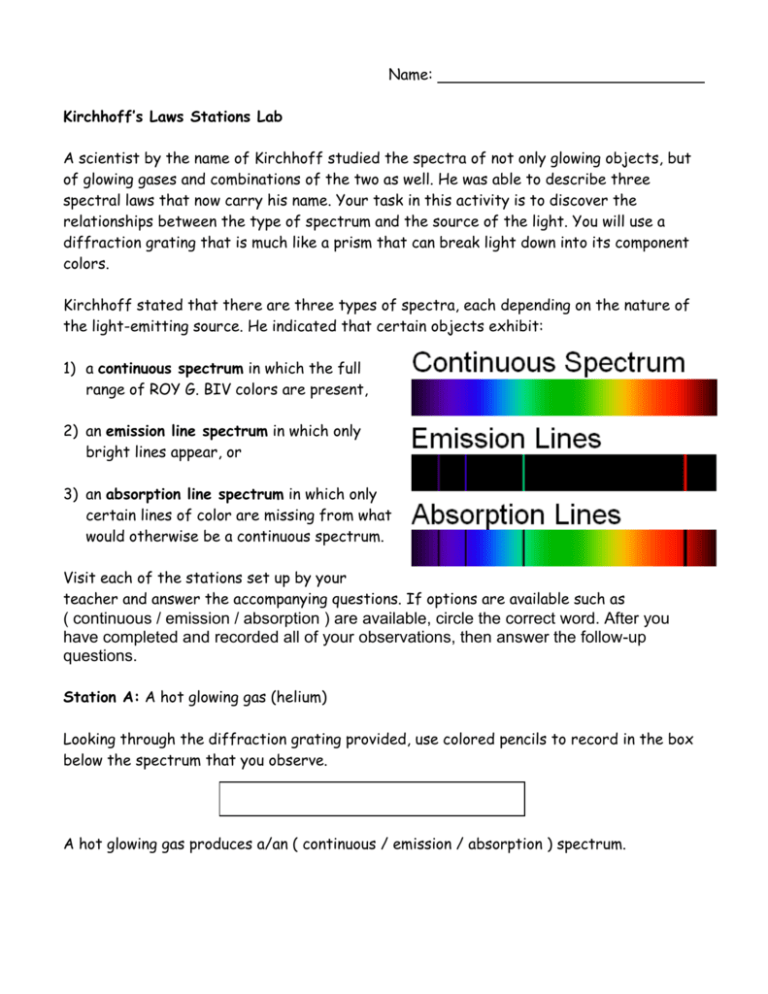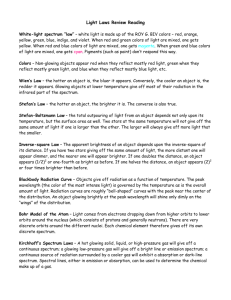Name:
advertisement

Name: Kirchhoff’s Laws Stations Lab A scientist by the name of Kirchhoff studied the spectra of not only glowing objects, but of glowing gases and combinations of the two as well. He was able to describe three spectral laws that now carry his name. Your task in this activity is to discover the relationships between the type of spectrum and the source of the light. You will use a diffraction grating that is much like a prism that can break light down into its component colors. Kirchhoff stated that there are three types of spectra, each depending on the nature of the light-emitting source. He indicated that certain objects exhibit: 1) a continuous spectrum in which the full range of ROY G. BIV colors are present, 2) an emission line spectrum in which only bright lines appear, or 3) an absorption line spectrum in which only certain lines of color are missing from what would otherwise be a continuous spectrum. Visit each of the stations set up by your teacher and answer the accompanying questions. If options are available such as ( continuous / emission / absorption ) are available, circle the correct word. After you have completed and recorded all of your observations, then answer the follow-up questions. Station A: A hot glowing gas (helium) Looking through the diffraction grating provided, use colored pencils to record in the box below the spectrum that you observe. A hot glowing gas produces a/an ( continuous / emission / absorption ) spectrum. Station B: A hot glowing gas (mercury) Looking through the diffraction grating provided, use colored pencils to record in the box below the spectrum that you observe. A hot glowing gas produces a/an ( continuous / emission / absorption ) spectrum. Station C: A cooler glowing gas in front of a hotter glowing solid. Looking through the diffraction grating provided, use colored pencils to record in the box below the spectrum that you observe. A cooler glowing gas in front of a hotter glowing solid produces a/an ( continuous / emission / absorption ) spectrum. Station D: A hot glowing solid (light bulb) Looking through the diffraction grating provided, use colored pencils to record in the box below the spectrum that you observe. A hot glowing solid produces a/an ( continuous / emission / absorption ) spectrum. Station E: Spectroscope (Warning: Look only at the sky but NOT the sun.)* Looking through the spectroscope provided, gather light from a brighter portion of the sky but NOT the sun. Look very carefully for very thin lines in the spectrum. Use colored pencils to record in the box below the spectrum that you observe. The sky produces a/an ( continuous / emission / absorption ) spectrum. Note that the sky spectrum is essentially the spectrum of the sun. Sunlight is scattered around the sky and then enters the spectroscope. Questions: 1) Are any two spectra similar? If yes, which ones? Stations: and 2) Of these two similar spectra, what is the nature of the glowing source of light? ( hot glowing solid / hot glowing gas / hot glowing gas in front of a hotter glowing solid ) 3) How are the above two sources clearly different? ( different temperature / different gas / different state of matter ) 4) Are any other two spectra similar? If yes, which ones? Stations: and 5) Of these two similar spectra, what is the nature of the glowing source of light? ( hot glowing solid / hot glowing gas / hot glowing gas in front of a hotter glowing solid ) 6) How are the above two sources clearly different? ( different temperature / different gas / different state of matter ) Note to the teacher: An absorption spectrum also can be obtained in class by shining a bright light (slide projector?) through a clear container containing water and a modest amount of Windex cleaning solution.









